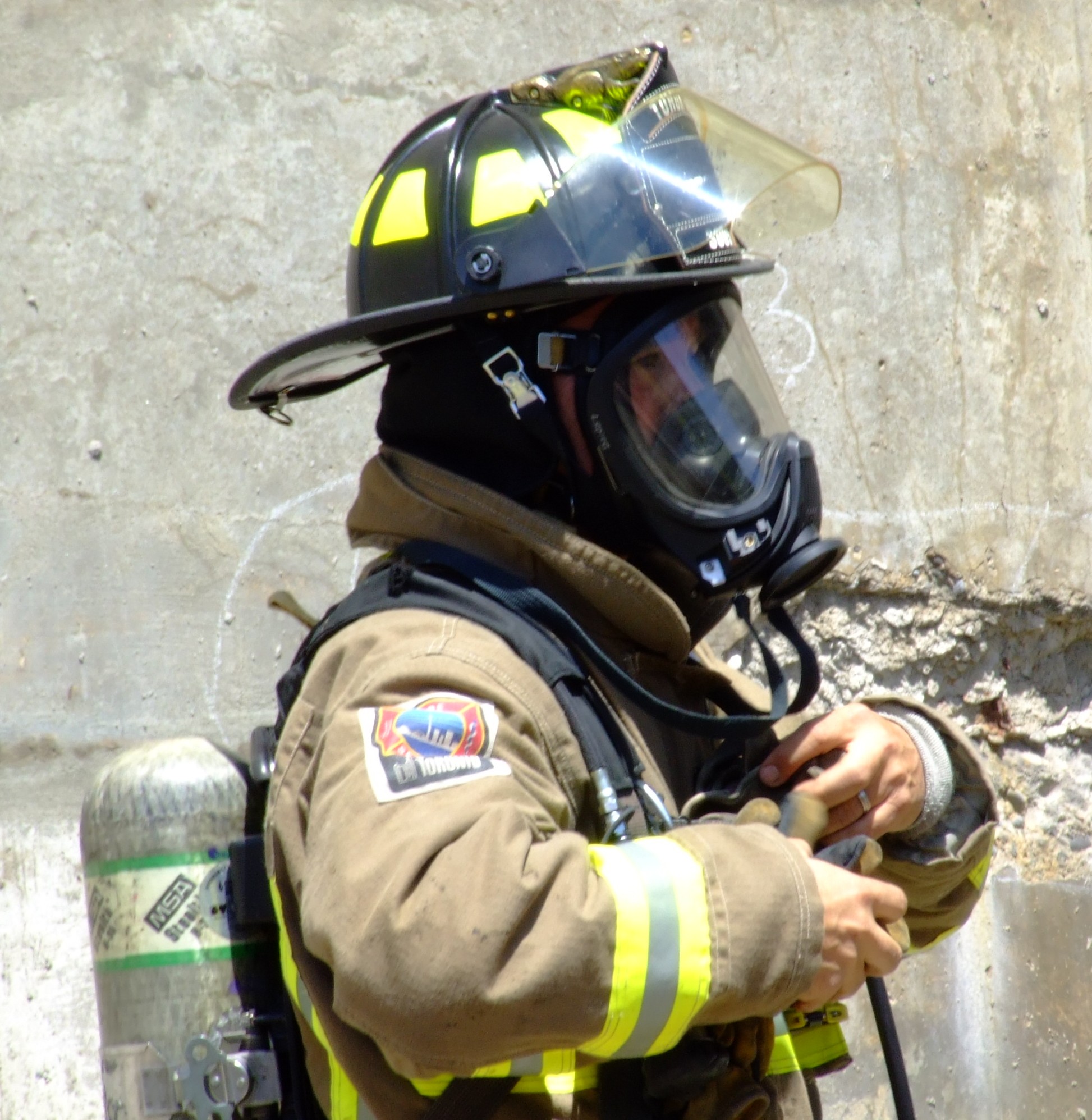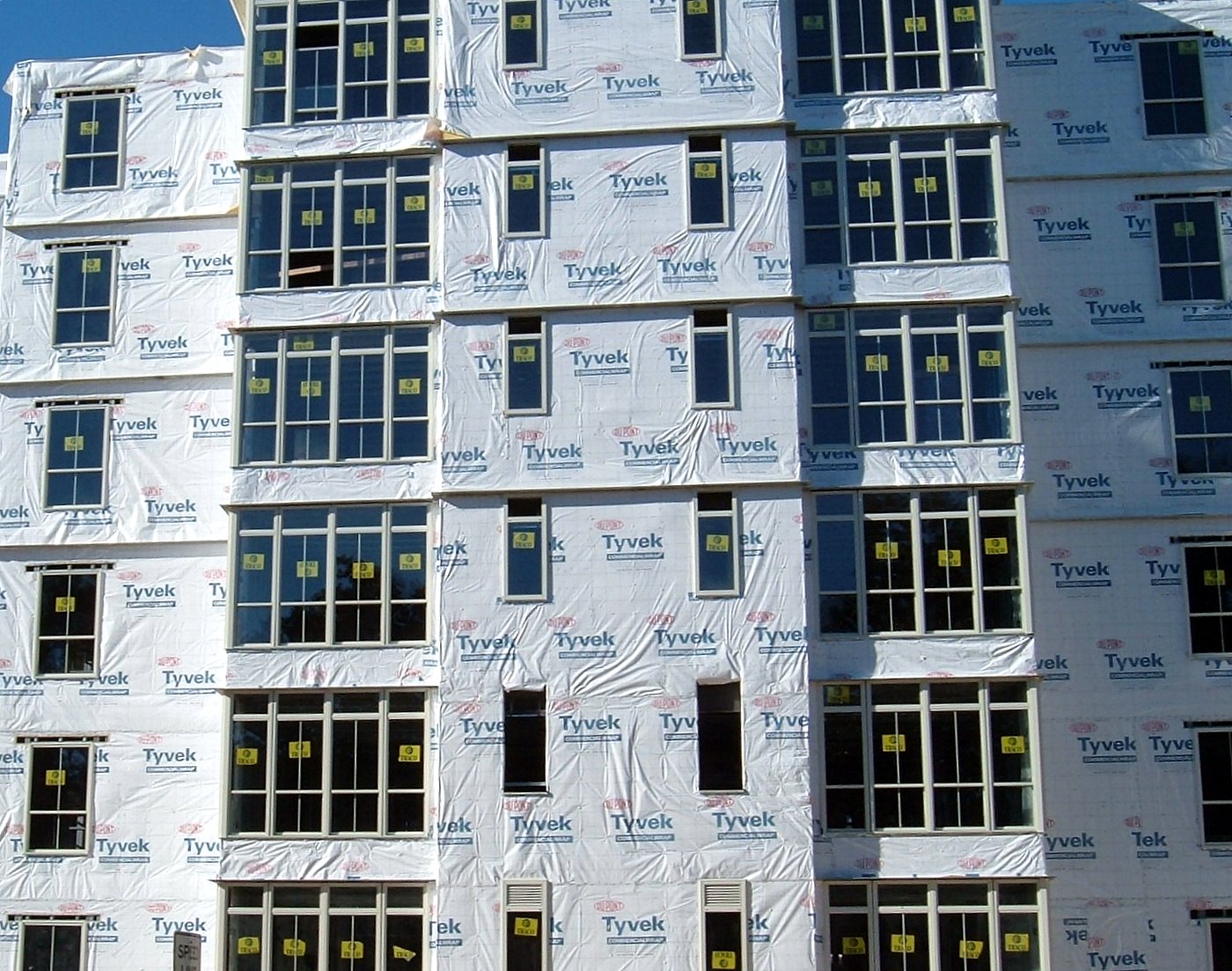|
Supplied-air Respirator
A supplied-air respirator (SAR) or air-line respirator is a breathing apparatus used in places where the ambient air may not be safe to breathe. It uses an air hose to supply air from outside the danger zone. It is similar to a self-contained breathing apparatus (SCBA), except that SCBA users carry their air with them in high pressure cylinders, while SAR users get it from a remote stationary air supply connected to them by a hose. Description SARs are lightweight, but tether the user. Unlike SCBAs, the worker will not run out of air when the tank they carry is empty. They can therefore be used for longer continuous work periods. The mask end of a SAR is generally lower-maintenance than an SCBA, but the air compressors or tanks at the other end of the hose require monitoring and maintenance. It is important that they deliver good air; contaminants (which may also be introduced by faulty operation of the machinery) can be dangerous. If the air-supply line is cut or pinched shu ... [...More Info...] [...Related Items...] OR: [Wikipedia] [Google] [Baidu] |
Self-contained Breathing Apparatus
A self-contained breathing apparatus (SCBA), sometimes referred to as a compressed air breathing apparatus (CABA) or simply breathing apparatus (BA), is a device worn to provide breathable air in an atmosphere that is immediately dangerous to life or health. They are typically used in firefighting and industry. The term ''self-contained'' means that the SCBA is not dependent on a remote supply of breathing gas (e.g., through a long hose). If designed for use under water, it is also known as a Scuba set (self-contained underwater breathing apparatus). When not used underwater, they are sometimes called industrial breathing sets. Unofficial names include ''air pack'', ''air tank'', ''oxygen cylinder'' or simply ''pack'', which are mostly used in firefighting. An SCBA typically has three main components: a high-pressure tank (e.g., , about 150 to 374 atmospheres), a pressure regulator, and an inhalation connection (mouthpiece, mouth mask or face mask), connected together and mou ... [...More Info...] [...Related Items...] OR: [Wikipedia] [Google] [Baidu] |
Powered Air-purifying Respirator
A powered air-purifying respirator (PAPR) is a type of respirator used to safeguard workers against contaminated air. PAPRs consist of a headgear-and-fan assembly that takes ambient air contaminated with one or more type of pollutant or pathogen, actively removes (filters) a sufficient proportion of these hazards, and then delivers the clean air to the user's face or mouth and nose. They have a higher assigned protection factor than filtering facepiece respirators such as N95 masks. PAPRs are sometimes called positive-pressure masks, blower units, or just blowers. Description The modularity of PAPRs allows them to be customized for different working environments. Regardless of type, a PAPR consists of: * some kind of headgear (mask or hood), * a powered (motor-driven) fan which forces incoming air into the device, * a filter (or multiple filters) for delivery to the user for breathing, and * a battery or other power source. The mask may be hard and tight-fitting, or flexi ... [...More Info...] [...Related Items...] OR: [Wikipedia] [Google] [Baidu] |
Tyvek
Tyvek () is a brand of synthetic flashspun high-density polyethylene fibers. The name "Tyvek" is a registered trademark of the American multinational chemical company DuPont, which discovered and commercialized Tyvek in the late 1950s and early 1960s. Tyvek's properties - such as being difficult to tear but easily cut, and waterproof against liquids whilst allowing water vapor to penetrate - have led to it being used in a variety of applications. Tyvek is often used as housewrap, a synthetic material used to protect buildings during construction, or as personal protective equipment (PPE). History Tyvek is a nonwoven product consisting of spun bond olefin fiber. It was first discovered in 1955 by a researcher for the DuPont textile company working in an experimental lab, who noticed a type of white fluff coming out of a pipe. That fluff was a form of polyethylene, which DuPont requested a patent for within a year of the discovery. After technologies improved during the next few ... [...More Info...] [...Related Items...] OR: [Wikipedia] [Google] [Baidu] |
Polyethylene
Polyethylene or polythene (abbreviated PE; IUPAC name polyethene or poly(methylene)) is the most commonly produced plastic. It is a polymer, primarily used for packaging ( plastic bags, plastic films, geomembranes and containers including bottles, etc.). , over 100 million tonnes of polyethylene resins are being produced annually, accounting for 34% of the total plastics market. Many kinds of polyethylene are known, with most having the chemical formula (C2H4)''n''. PE is usually a mixture of similar polymers of ethylene, with various values of ''n''. It can be ''low-density'' or ''high-density'': low-density polyethylene is extruded using high pressure () and high temperature (), while high-density polyethylene is extruded using low pressure () and low temperature (). Polyethylene is usually thermoplastic, but it can be modified to become thermosetting instead, for example, in cross-linked polyethylene. History Polyethylene was first synthesized by the German chemist Hans ... [...More Info...] [...Related Items...] OR: [Wikipedia] [Google] [Baidu] |
Polypropylene
Polypropylene (PP), also known as polypropene, is a thermoplastic polymer used in a wide variety of applications. It is produced via chain-growth polymerization from the monomer propylene. Polypropylene belongs to the group of polyolefins and is partially crystalline and non-polar. Its properties are similar to polyethylene, but it is slightly harder and more heat-resistant. It is a white, mechanically rugged material and has a high chemical resistance. Bio-PP is the bio-based counterpart of polypropylene (PP). Polypropylene is the second-most widely produced commodity plastic (after polyethylene). In 2019, the global market for polypropylene was worth $126.03 billion. Revenues are expected to exceed US$145 billion by 2019. The sales of this material are forecast to grow at a rate of 5.8% per year until 2021. History Phillips Petroleum chemists J. Paul Hogan and Robert Banks first demonstrated the polymerization of propylene in 1951. The stereoselective polymerization t ... [...More Info...] [...Related Items...] OR: [Wikipedia] [Google] [Baidu] |
Oxygen-deficient Atmosphere
Inert gas asphyxiation is a form of asphyxiation which results from breathing a physiologically inert gas in the absence of oxygen, or a low amount of oxygen, rather than atmospheric air (which is composed largely of nitrogen and oxygen). Examples of physiologically inert gases, which have caused accidental or deliberate death by this mechanism, are argon, helium, nitrogen and methane. The term "physiologically inert" is used to indicate a gas which has no toxic or anesthetic properties and does not act upon the heart or hemoglobin. Instead, the gas acts as a simple diluent to reduce oxygen concentration in inspired gas and blood to dangerously low levels, thereby eventually depriving all cells in the body of oxygen. According to the U.S. Chemical Safety and Hazard Investigation Board, in humans, "breathing an oxygen deficient atmosphere can have serious and immediate effects, including unconsciousness after only one or two breaths. The exposed person has no warning and cannot sens ... [...More Info...] [...Related Items...] OR: [Wikipedia] [Google] [Baidu] |
Immediately Dangerous To Life Or Health
The term immediately dangerous to life or health (IDLH) is defined by the US National Institute for Occupational Safety and Health (NIOSH) as exposure to airborne contaminants that is "likely to cause death or immediate or delayed permanent adverse health effects or prevent escape from such an environment." Examples include smoke or other poisonous gases at sufficiently high concentrations. It is calculated using the LD50 or LC50. The Occupational Safety and Health Administration (OSHA) regulation (1910.134(b)) defines the term as "an atmosphere that poses an immediate threat to life, would cause irreversible adverse health effects, or would impair an individual's ability to escape from a dangerous atmosphere." IDLH values are often used to guide the selection of breathing apparatus that are made available to workers or firefighters in specific situations. The NIOSH definition does not include oxygen deficiency (below 19.5 percent) although atmosphere-supplying breathing appara ... [...More Info...] [...Related Items...] OR: [Wikipedia] [Google] [Baidu] |
N95 Mask
An N95 filtering facepiece respirator, commonly abbreviated N95 respirator, is a particulate-filtering facepiece respirator that meets the U.S. National Institute for Occupational Safety and Health (NIOSH) N95 classification of air filtration, meaning that it filters at least 95% of airborne particles. This standard does not require that the respirator be resistant to oil; another standard, P95, adds that requirement. The N95 type is the most common particulate-filtering facepiece respirator. It is an example of a mechanical filter respirator, which provides protection against particulates but not against gases or vapors. An authentic N95 respirator is marked with the text "NIOSH" or the NIOSH logo, the filter class ("N95"), a "TC" approval number of the form XXX-XXXX, the approval number must be listed on the NIOSH Certified Equipment List (CEL) or the NIOSH Trusted-Source page, and it must have headbands instead of ear loops. The N95 mask filter was invented by Taiwanese-Am ... [...More Info...] [...Related Items...] OR: [Wikipedia] [Google] [Baidu] |
Respirator
A respirator is a device designed to protect the wearer from inhaling hazardous atmospheres including fumes, vapours, gases and particulate matter such as dusts and airborne pathogens such as viruses. There are two main categories of respirators: the ''air-purifying respirator'', in which respirable air is obtained by filtering a contaminated atmosphere, and the ''air-supplied respirator'', in which an alternate supply of breathable air is delivered. Within each category, different techniques are employed to reduce or eliminate noxious airborne contaminants. Air-purifying respirators range from relatively inexpensive, single-use, disposable face masks sometimes referred to as a filtering facepiece respirator to a more robust reusable model with replaceable cartridges called an elastomeric respirator. Powered air-purifying respirators (PAPR), use a pump or fan to constantly move air through a filter and supply purified air into a mask, helmet or hood. Physical form All res ... [...More Info...] [...Related Items...] OR: [Wikipedia] [Google] [Baidu] |
Firefighting
Firefighting is the act of extinguishing or preventing the spread of unwanted fires from threatening human lives and destroying property and the environment. A person who engages in firefighting is known as a firefighter. Firefighters typically undergo a high degree of technical training. This involves structural firefighting and wildland firefighting. Specialized training includes aircraft firefighting, shipboard firefighting, aerial firefighting, maritime firefighting, and proximity firefighting. Firefighting is a dangerous profession due to the toxic environment created by combustible materials, with major risks are smoke, oxygen deficiency, elevated temperatures, poisonous atmospheres, and violent air flows. To combat some of these risks, firefighters carry self-contained breathing apparatus. Additional hazards include falls — a constant peril while navigating unfamiliar layouts or confined spaces amid shifting debris under limited visibility – and structural collapse t ... [...More Info...] [...Related Items...] OR: [Wikipedia] [Google] [Baidu] |
Industrial Breathing Sets
A self-contained breathing apparatus (SCBA), sometimes referred to as a compressed air breathing apparatus (CABA) or simply breathing apparatus (BA), is a device worn to provide breathable air in an atmosphere that is immediately dangerous to life or health. They are typically used in firefighting and industry. The term ''self-contained'' means that the SCBA is not dependent on a remote supply of breathing gas (e.g., through a long hose). If designed for use under water, it is also known as a Scuba set (self-contained underwater breathing apparatus). When not used underwater, they are sometimes called industrial breathing sets. Unofficial names include ''air pack'', ''air tank'', ''oxygen cylinder'' or simply ''pack'', which are mostly used in firefighting. An SCBA typically has three main components: a high-pressure tank (e.g., , about 150 to 374 atmospheres), a pressure regulator, and an inhalation connection (mouthpiece, mouth mask or face mask), connected together and mount ... [...More Info...] [...Related Items...] OR: [Wikipedia] [Google] [Baidu] |






